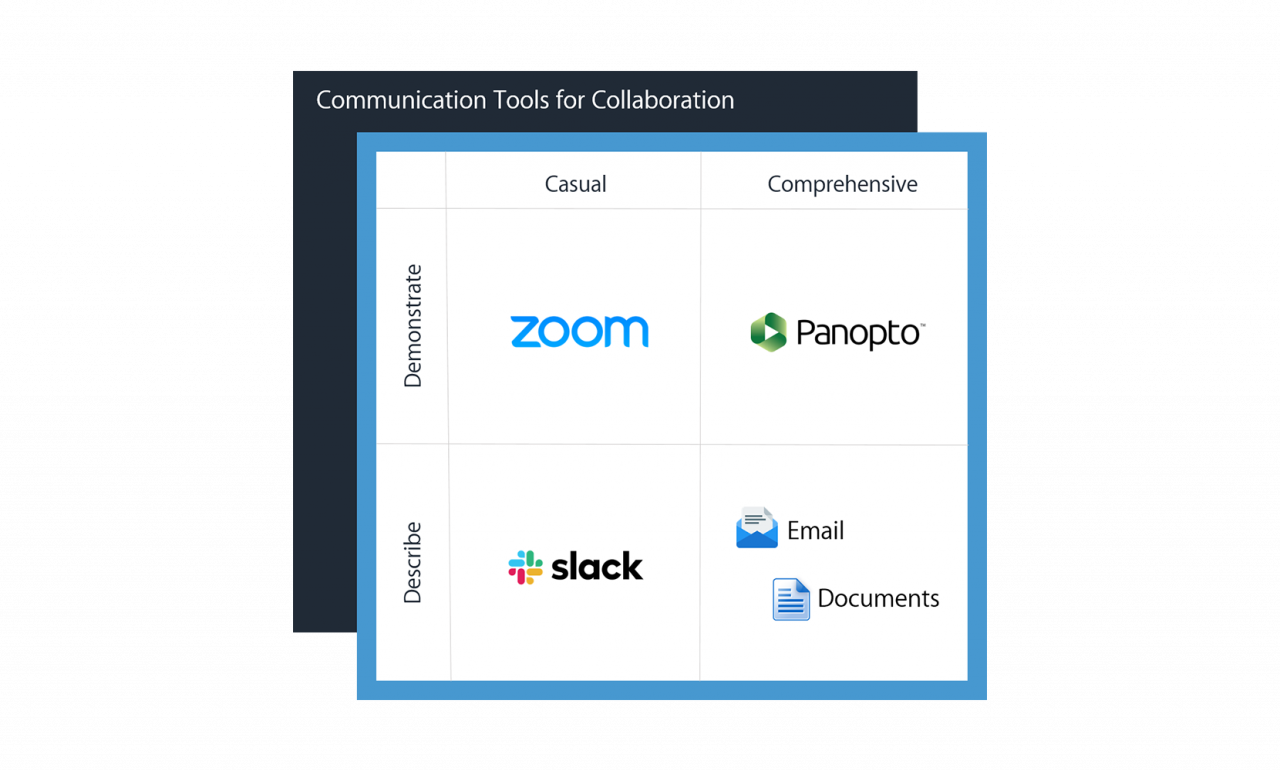- Collaboration
Do New Digital Communications Tools Mean The Death of Email?

Impossible as it may sound today, email was once a boon to workplace productivity. With the ability to type out a message, press send, and get a (usually) equally quick reply, people could get answers and share information much more efficiently than they had been able to before.
Email presented really the first practical form of asynchronous communication, a means of exchanging information that wasn’t quite in real-time, but also didn’t take hours or days on end to complete. Using email meant there was no longer a need to wait for intra-office mail. It meant fewer days-long games of phone-tag, or back and forth voicemails. It meant less time wasted tracking down coworkers who weren’t at their desks when they were needed. And it meant far less time and resources spent on in-person meetings (especially those that previously would have required travel time).
In short order, professionals everywhere jumped at the opportunity to work more efficiently and began to replace a significant portion of the interactions that used to unfold in person or over the phone with email.
It wasn’t long, though, before email communications started to become chaotic and overwhelming to even the average worker.
With email, there was no way of knowing when a message would come in or where it would fall in a long list of other priorities. And as a result, workers have become beholden to their inboxes — continually checking for new messages, assessing urgency, picking through message after message in a lengthy chain of discussions, sending a reply or sidelining it for later. It’s a system that often distracts people from their real work and slows down productivity simply by diverting focus away from other important tasks that require their full attention.
And almost as quickly as it won acclaim as a productivity booster, email soon found itself relabeled a productivity killer.
The Problem With Email
At a fundamental level, the problem with email stems from its versatility. Email is functionally free and virtually effortless to send, which meant that people began defaulting to email for most any exchange.
Soon, a tool that was designed for communication and collaboration at work would be pressed into service anytime anyone had any thought they wanted to share. There were emails that should have been meetings, emails that just needed a quick answer, emails that should have been a presentation, emails with only a subject line (EOM), and even emails to the entire office about “Donuts in the kitchen!” with a barrage of useless reply-all messages to follow.
And as a result, today each of us has at one time or another been bogged down with:
- Too many emails
- Emails that are too long
- Too many replies on an email chain with no action or resolution
- Waiting too long for a reply on an email
- And far too many emails that simply aren’t important or relevant
With so much frustration mounting over the deluge of email, it wasn’t long before new communications tools began to appear that could potentially alleviate the pain.
Replacing Email With New Communications Channels
In the last few years, a variety of new synchronous digital communications tools have soared in popularity. These solutions are designed to enable workers to communicate and collaborate in real-time without leaving their desks — and demand for these systems has largely come from overwhelmed employees desperately seeking an alternative to email. You’ve likely already heard of many of these purported email killers.
Workplace Chat Apps
Slack has become one of the most well-known chat apps for professionals, enabling people to instantly source quick input from teammates via searchable chat. The rapid rise in adoption of Slack’s chat app has also spawned competition from other tech behemoths including Microsoft Teams, Facebook Workplace, and Google’s G Suite Hangouts for teams, cementing this type of technology in corporate IT ecosystems everywhere.
These tools amplify the immediacy of email anytime someone needs a quick response. Have a question? Just Slack a coworker directly, or pop a message in a channel full of people who can help. Can’t remember the project details you and your teammate chatted about two weeks ago? Simply type a search into Slack to find it again.
If the information you need is something you could reasonably expect a colleague to answer in a line or two of text, these apps are the next best thing to a quick IRL conversation.
Real-Time Video Conferencing
Zoom, GoToMeeting, Skype for Business (which is becoming part of Microsoft Teams), BlueJeans, and WebEx all offer varying solutions for real-time video communications and collaboration, enabling teams to collaborate remotely via face-to-face video communications and screen shares with just a few clicks. And the video conferencing market is currently one of the fastest growing technology segments out there — Global Market Insights predicts the video conferencing market to hit $20 billion by 2024, growing at an annual rate of 14 percent.
Thanks to these systems, a huge number of those emails that should have been a phone call are now gone. Instead, you can instantly talk live with coworkers anywhere and share anything on your screen just by sending a link.
Likewise, all those messy email exchanges with 20 different recipients all replying over each other can disappear as well. Now they can be replaced by a virtual meeting that enables a group of people to reach a consensus and make decisions far more efficiently.
But Is More Immediate Communication Better?
Well, sometimes yes, and sometimes no.
The ability to communicate digitally, in real-time, through chat and video conferencing apps has given people a better way to get quick answers and have productive ad-hoc discussions. And as a result, the sheer volume of emails that are being sent within organizations that have adopted these tools is steadily declining. Not only do real-time messaging apps naturally deter people from sending unnecessary or ineffective emails, but also the immediacy of communication and better access to institutional knowledge can make workers even more productive.
Does this mean the death of email will soon be upon us? It’s unlikely.
Email still has its advantages. When it comes to sharing more formal, nuanced, complex, and/or detailed communications, messages that genuinely don’t require an immediate response, exchanging information with remote teammates, or connecting with people outside of your organization, email tends to be a better medium.
Where Email, Chat Apps, and Video Conferencing Still Fail
For all the productivity gains this new communications stack offers, internal communications at work could still be more efficient and effective. There are some types of information that, without a better medium, are being shoehorned into communications channels that aren’t quite right.
Today’s knowledge workers often need to communicate and explain complex processes and concepts in detail to their peers. In a perfect world, these subjects would be presented in person — a colleague would tap another on the shoulder and ask for a walk-through of the problem or process in question.
However, today’s overbooked schedules and remote working arrangements often make those kind of comprehensive information exchanges impossible. And so, to make due, we try to capture as much of what we would have just happily presented in person in real-time into, instead, a formally-documented asynchronous message.
But not only do detailed emails or documents — complete with screenshots, charts, and other data — take a long time to create, no one else really wants to read a 500-word email or that 6-page document you’ve attached. That kind of information is often overwhelming and almost impossible to follow along, and even when a coworker does dig through it all, almost always the information is quickly forgotten anyway.
Chat apps aren’t a better alternative — you’re still sharing a lengthy written document that isn’t an efficient means for communicating detailed information. And it’s just not necessary put another meeting on people’s calendars so you can present the information in a live video conference — where, unless you record it, that information is largely lost after, or you’re doing twice the work to also create a written document that people can reference later.
So what’s better than email, chat, and video conferencing for comprehensive communications and detailed information sharing?
On-demand, searchable video.
With video, every frame is worth 1,000 words. Demonstrating and presenting information or ideas in a video presentation is far more efficient than spending hours and hours creating a full text-based email or document. And what’s more, in the age of YouTube, a majority of people now actually prefer to learn new things and get information via video instead of text.
The Rise Of The Video Platform
Today, more and more businesses are bringing another communication and collaboration tool into the mix.
A modern video platform offers a more efficient way of communicating comprehensive information through easy-to-capture, on-demand, searchable multi-camera videos. In fact, you can create a searchable video asset in the same amount of time it takes to do a presentation. So instead of spending hours typing up and screenshotting all the details you need to share, you simply turn on your webcam, share your screen, press record, and start presenting.
Watch an example of an explainer video created by one of our engineers with the Panopto video platform:
In fact, a growing number of organizations are even recording and archiving every meeting their employees hold. With a digital meeting recording asset, employees can engage fully in the meeting without taking notes, meeting leaders can skip typing and sending detailed email summaries after, and those who weren’t there can watch the recording to get every detail exactly as it happened.
Related Reading: Why Your Company Should Be Recording All Of Its Meetings
Perhaps most importantly, a video platform makes it easy to both share on-demand videos securely and to search all of the content inside of them — just like you can with email or Slack.
Panopto’s video platform, for example, includes integrations for single sign-on (SSO) identity management systems and video conferencing systems that make it possible to restrict access and set sharing permissions for your videos so your people can easily share them with colleagues just like you would a YouTube video. Panopto’s Smart Search also indexes every word spoken and every word shown on screen inside a video, so with a quick search, people can instantly find information stored in your video library and jump to the exact moment that topic is discussed.
Optimizing Workplace Communications With The Right Mix Of Tools

It’s Not One Solution vs. Another
Moving away from the one-size-fits-all approach to internal communications tools, workers are pushing their organizations to better support digital communications through several different mediums that enable them to communicate and collaborate through the channel that will produce the best results.
An organization’s full communications stack should provide options for both synchronous and asynchronous conversations and information-sharing. This means companies are supporting a mix of integrated tools that include:
- Email and document sharing for formal communications.
- Searchable chat apps that enable rapid text-based communications.
- Video conferencing software to enable quick face-to-face conversations.
- A video platform that enables the sharing of searchable, on-demand video communications, demonstrations, and tutorials.
Is Email Dying?
Not anytime soon. New communications solutions now simply better facilitate all those email communications that should have never been emails in the first place. And it’s making workers everywhere happier and more productive.
Ultimately, with new options eliminating the worst of our email habits and thus creating fewer emails for everyone to sift through, email could potentially return to its place as a productive communications medium again.
Complete Your Unified Communications Stack With Panopto
Panopto’s enterprise video platform will help you record meetings, trainings, and presentations, then archive the on-demand video content so they can be searched, discovered, and used again later. Want to see Panopto in action? Contact us for a free trial.




